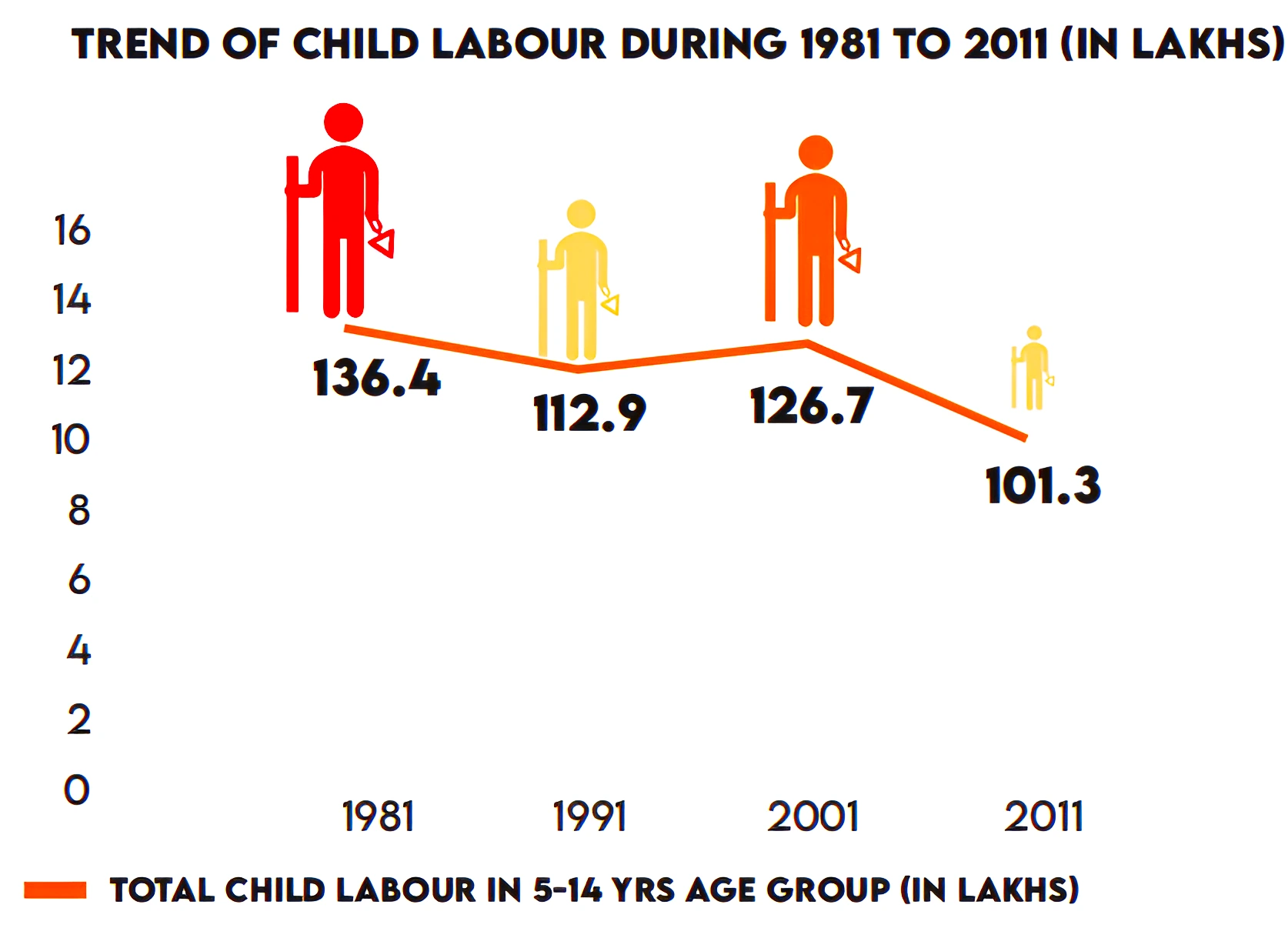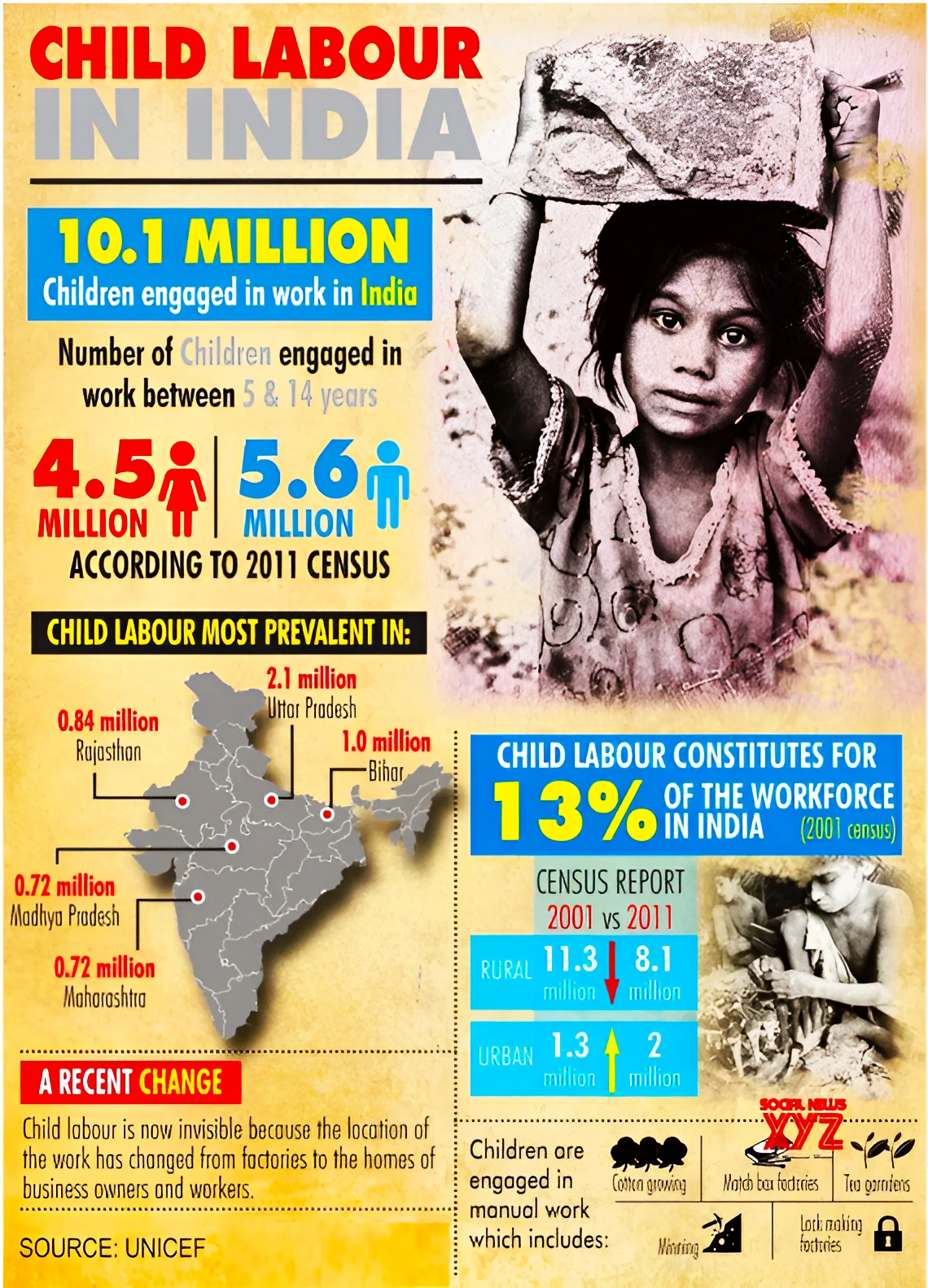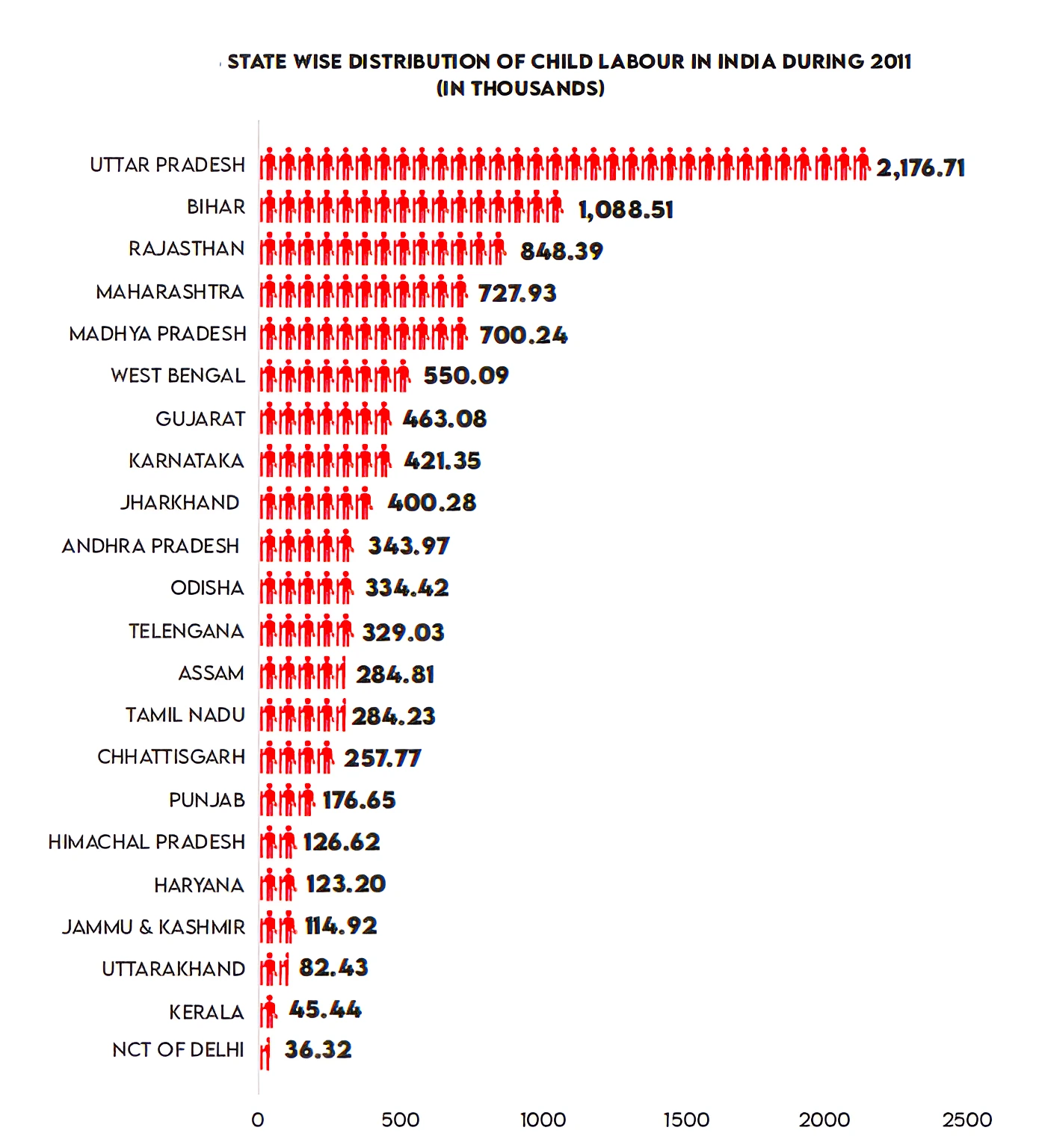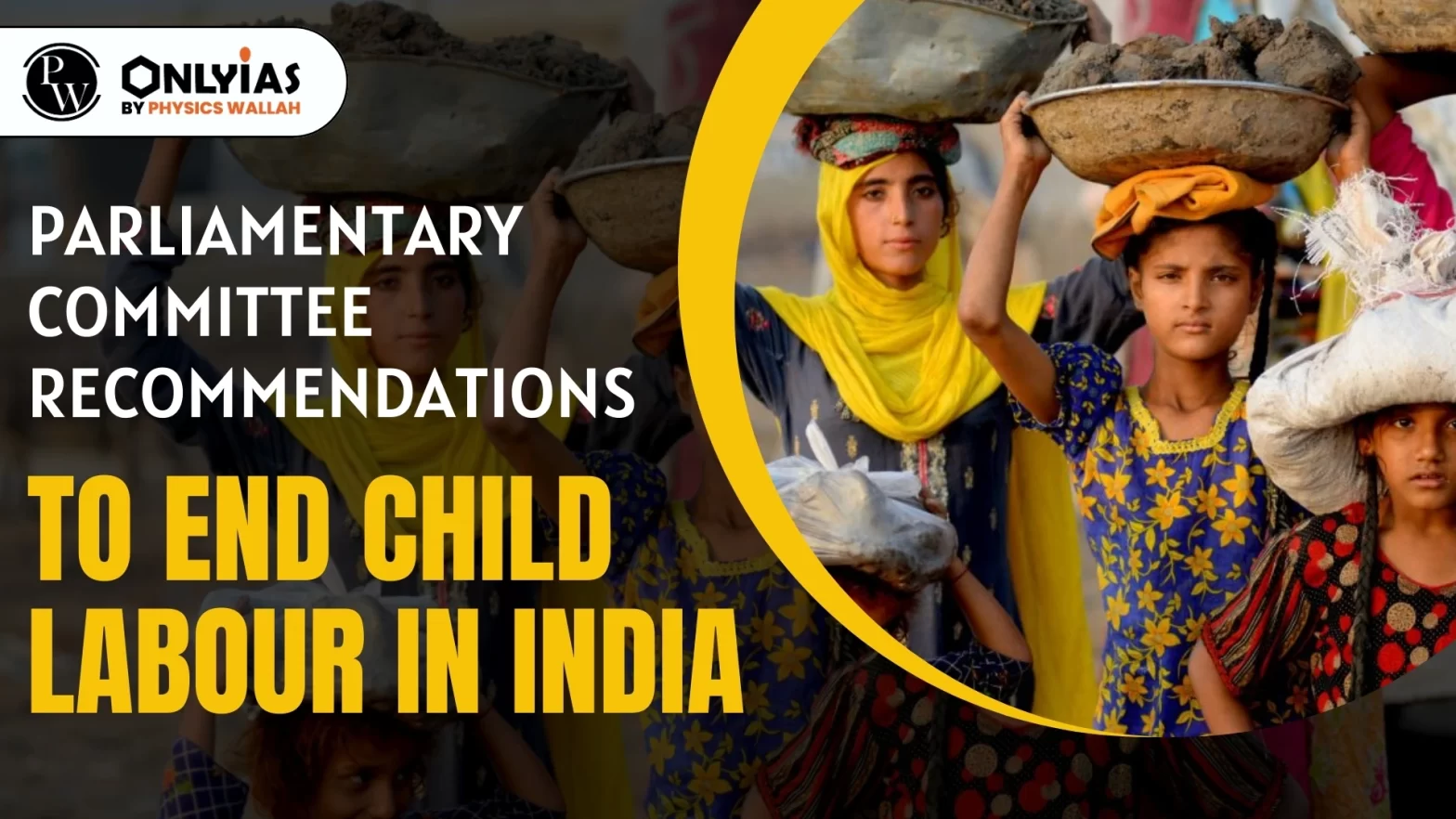Context: This article is based on the news “Parliamentary panel recommends stricter action to end child labour in India” which was published in the Economic Times. The Parliamentary Standing Committee on Labour has recently tabled a detailed report titled ‘National Policy on Child Labour – An Assessment’ in Parliament on the implementation of the Centre’s policy on child labour in India.
| Relevancy for Prelims: CENSUS & Survey DATA on Child Labour in India, Parliamentary Standing Committee, Child Labour (Prohibition and Regulation) Act, (CLPRA) 1986, Child Labour (Prohibition and Regulation) Act 1986, and National Policy on Child Labour.
Relevancy for Mains: Parliamentary Committee Recommendations to End Child Labour In India. |
CENSUS & Survey DATA on Child Labour in India

- State of Working Children: The number of working children has decreased from 1.26 crore (as per 2001 census) to 1.01 crore (as per 2011 census).
- The number of working children in the age group of 5-14 years has also decreased from 57.79 lakh (as per 2001 census) to 43.53 lakh (as per 2011 census).
- Survey on Child Labour in India: According to the committee, the Ministry of Labour does not conduct any survey to ascertain the number of child labourers across the country.
- The Ministry have stated that no proposal is under their consideration to develop a mechanism to maintain child labour data except depending on census data.
- Eliminate Child Labour in India by 2025: Considering the prevalence of child labour at present, it is practically not possible to meet the international commitment to eliminate child labour by 2025.
 For complete elimination of child labour in India by 2025, the decline in number of child labour has to increase from 1.9 lakh per annum to 12.4 lakh per annum.
For complete elimination of child labour in India by 2025, the decline in number of child labour has to increase from 1.9 lakh per annum to 12.4 lakh per annum.
About Child Labour
- Definition: According to the International Labour Organisation, child labour is often defined as work that deprives children of their childhood, their potential and their dignity, and that is harmful to physical and mental development.
- It refers to work that is mentally, physically, socially or morally dangerous and harmful to children.
- It refers to work that interferes with their schooling by depriving them of the opportunity to attend school.
- Worst Forms of Child Labour: It involves children being enslaved, separated from their families, exposed to serious hazards and illnesses and/or left to fend for themselves on the streets of large cities, often at a very early age.
Must Read: Periodic Labour Force Survey (PLFS) Annual Report 2022
Parliamentary Standing Committee: Recommendations to End Child Labour In India?
- Recommendations of Parliamentary Panel: The report touches upon almost all aspects of the issue, and recommends various Ministries of the Centre and the States take coordinated steps to address it.
- Clearing Ambiguity for Determination of Age: The committee has recommended that discrepancies in the criteria for determination of the age of the child in various Acts, as well as the provisions of offence being cognisable/non-cognisable under the Child and Adolescent Labour (Prohibition and Regulation) Act, 1986, and Juvenile Justice (Care and Protection of Children) Act, 2015 be examined to ensure they did not lead to any ambiguity or delay in securing justice for aggrieved children.
- Zero Tolerance on Child Labour in India: The committee has also recommended that, in addition to the three-four times increase in the amount of fine, stricter punishment in the form of cancellation of license, attachment of property, etc., needed to be incorporated to protect the interests of children.
- Union Labour Ministry should pursue this in order to have zero tolerance on child labour in India.
- Maintain Child Labour Data: Committee urged the Ministry of Labour to take up collecting data on children between 14 to 18 years during the next Census exercise with the Ministry of Home Affairs so as to have reliable data on children and adolescents.
- The Committee impress upon the Ministry to conduct periodic survey particularly in urban areas to identify child labours.
- The panel also asked the Centre to direct States conduct surveys to identify child labour in India, collect and furnish enforcement data, along with their suggestions to address the problem.
- Devise Action Plan: The Committee impress upon the Ministry to take up the issue in a mission mode and devise a systematic action plan based policy to meet international commitments, which are not only relevant for economic development of the country but will also brighten the image of the country in the international forum.
- Fixing Accountability: According to the committee, in addition to the employer, the accountability of the principal employer and traffickers should be fixed.
Child Labour in India: Challenges
- Poverty: Many families living in poverty are compelled to send their children to work in order to supplement the family income. In India, not putting a child to work could means the family would not make enough income to sustain their living.
- This forced child labor is unethical because it is against the autonomy of the children while the consent of the working child is mostly manipulated by the parents.
- Lack of Education: Limited access to quality education, especially in rural areas, contributes to child labor. When children do not have access to proper schooling, they are more likely to engage in labor at an early age.
 Government has taken measures to keep children out of factories, and put them in schools hoping it will empower children with skills that can help boost their incomes in the future. But, quite often, the standard of public schooling is abysmal as they fail in imparting useful skills.
Government has taken measures to keep children out of factories, and put them in schools hoping it will empower children with skills that can help boost their incomes in the future. But, quite often, the standard of public schooling is abysmal as they fail in imparting useful skills.
- Risks Faced by Child Workers: They are exposed to the risks of contracting occupational diseases like skin diseases, diseases of the lungs, weak eyesight, TB etc. Further, they are vulnerability to sexual exploitation at the workplace.
- Social and Cultural Factors: Some cultural norms and traditions may perpetuate child labor, as certain communities may view it as acceptable for children to work from a young age. Social attitudes towards child labor can influence its prevalence.
- Sociocultural aspects such as the caste system, discrimination, and cultural biases against girls contribute to child labour.
- Inadequate Implementation of Laws: Limited resources and corruption can hamper the effectiveness of the available legal measures.
- Despite the fact that more than 1 crore children were identified as labourers during 2011 Census, not much efforts have since been made to withdraw them from the labour situation. For instance, as per the National Crime Records Bureau Report 2022, in 2021, around 982 cases were registered under the Child Labour (Prohibition and Regulation) Act, (CLPRA) 1986.
- There is no Vigilance and Monitoring Committee under CLPR Act for identification, rescue and rehabilitation on the lines of Bonded Labour Abolition Act.
- The CLPR Act allows children below the age of 14 years to work in non-hazardous, family enterprises and entertainment industry and sports industry after school hours. This casts an additional burden on the child and deprives the child the right to development
- Informal Economy: A significant portion of child labor occurs in the informal economy, where regulations are often lax. Children may work in agriculture, small-scale industries, or as domestic helpers, making it challenging to monitor and regulate their working conditions.
- Inadequate Rehabilitation and Social Support: It has been found that there is lack of coordination among the law enforcement agencies dealing with issues relating to rehabilitation of children rescued from labour. As a result their rehabilitation continues to suffer.
Constitutional & Government Measures Undertaken to Eradicate Child Labour in India
- Constitution of India:
- Article 21A: Makes free and compulsory education a Fundamental Right for all Children of the age of 6-14 years.
- Article 23: Any type of forced labour is prohibited.
- Article 24: States that a child under 14 years cannot be employed to perform any hazardous work.
- Article 39: The health and strength of workers, men and women, and the tender age of children are not abused.
- Child Labour (Prohibition and Regulation) Act 1986: Based on the recommendations of Gurupadaswamy Committee, this act was enacted in 1986. It prohibits children under the age of 14 years to be working in hazardous industries and processes.
- Child Labour (Prohibition & Regulation) Amendment Act 2016: It prohibits the employment of Children below 14 years in all employment and with the provisions for prohibition on employment of adolescents (14-18 Years) in the mines, inflammable substances (explosives) and in hazardous process.
- National Policy on Child Labour in India: Formulated in 1987, it seeks to adopt a gradual & sequential approach with a focus on rehabilitation of children and Adolescent.
- Other Measures:
- Bonded Labour System (Abolition) Act 1976.
- SC/ST (Prevention of Atrocities) Act 1989.
- Juvenile Justice (Care and Protection of Children) Act 2015.
- International Conventions:
- India has ratified the Minimum Age Convention (No.138) and Worst forms of Child Labour Convention (No.182) of ILO.
- United Nations Convention on the Rights of the Child (UNCRC) Article 32 (Child Labour): The government should protect children from dangerous work harmful to health and business which is unsafe and unsuited for their development (physical, mental, spiritual, moral and social).
Way Forward to stop Child Labour in India
- Poverty Alleviation: Creation of income generation opportunities, especially in rural areas, at a large scale so that poor households have the money and the purchasing power making it unnecessary for them to send their children to work.
- For instance, the skill development among the rural people and setting up of agro based industries as also other micro and small scale industries can help in reducing the complete dependence on agriculture.
- There is a need to launch skills development programmes in rural areas by establishment of vocational training institutions on a large scale such as Industrial Training Institutes, Polytechnic Institutes etc.
- The idea of Universal Basic Income Scheme (UBIS) all households below a certain income may lead to alleviation of rural distress and is likely to disincentivise families from sending their children ones to work.
- Awareness Generation And Education: Economic factors for perpetuation of child labour are further compounded by total ignorance in the rural areas about the ill effects of child labour.
Role of panchayat in mitigating child labour
- Generate awareness about the ill-effects of child labour.
- Encourage parents to send their children to school.
- Create an environment where children stop working and get enrolled in schools instead.
- Ensure that children have sufficient facilities available in schools.
- Inform industry owners about the laws prohibiting child labour and the penalties for violating these laws.
- Activate Balwadis and Aanganwadis in the village so that working mothers do not leave the responsibility of younger children on their older siblings.
- Motivate Village Education Committees (VECs) to improve the conditions of schools.
|
-
- Launching awareness generation programmes on a large scale for making people aware of the value of education is an absolute necessity.
- Another important measure is extension of the entitlement of free and compulsory education up to higher secondary level which will enhance their enrolment rate and keep them away from labour or work.
- Rescue And Rehabilitation Of Existing Child Labour in India: It needs to be ensured that rescued child labour and their families get their entitlements as per the rehabilitation policy soon after their rescue.
- The rehabilitation process primarily focuses on socio-economic rehabilitation of the rescued child, however many children rescued from such situations need psychological support as well. Hence, it is necessary to modify the rehabilitation model from ‘socio-economic rehabilitation’ to ‘psycho-social and economic rehabilitation‘ model.
- Reducing Gaps between UNCRC and Indian Laws: CLPR Act should specifically provide for prevention, identification, rescue and rehabilitation of Child labour or adolescent on the lines of Bonded Labour System Abolition Act 1976.
- Further, children below the age of 14 years may be allowed to work only in the nuclear family enterprises and entertainment industry in a manner conducive to their growth, development and safety and with all prescribed legal safeguards including Right of Children to Free and Compulsory Education Act 2009.
- Effective Implementation Of Laws And Programmes: Coordination between the law enforcement agencies, civil society organisations, academicians and researchers working in the field of child protection and child rights has to be strengthened through gap identification, formulation of effective mitigation plans and their implementation.
- For instance, Kailash Satyarthi (founded Bachpan Bachao Andolan) recently appealed members of Parliament to support a Bill that extends the ban on child labour in India to include non-hazardous occupations like agriculture.
Conclusion:
Addressing child labour in India requires a multifaceted approach, including strict enforcement of existing laws, comprehensive awareness programs, poverty alleviation measures, and effective rehabilitation strategies, emphasizing the need for coordinated efforts across government agencies and civil society to ensure the well-being and development of every child.


 For complete elimination of child labour in India by 2025, the decline in number of child labour has to increase from 1.9 lakh per annum to 12.4 lakh per annum.
For complete elimination of child labour in India by 2025, the decline in number of child labour has to increase from 1.9 lakh per annum to 12.4 lakh per annum.  Government has taken measures to keep children out of factories, and put them in schools hoping it will empower children with skills that can help boost their incomes in the future. But, quite often, the standard of public schooling is abysmal as they fail in imparting useful skills.
Government has taken measures to keep children out of factories, and put them in schools hoping it will empower children with skills that can help boost their incomes in the future. But, quite often, the standard of public schooling is abysmal as they fail in imparting useful skills.